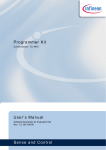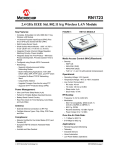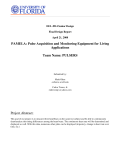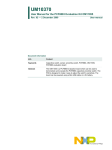Download User`s Manual KP106 Kit
Transcript
August 2007 KP106 Kit Evalkit for Pressure Sensors User’s Manual R e v. 1 . 0 Sense & Control Edition 2007-08-20 Published by Infineon Technologies AG 81726 Munich, Germany © 2007 Infineon Technologies AG All Rights Reserved. LEGAL DISCLAIMER THE INFORMATION GIVEN IN THIS APPLICATION NOTE IS GIVEN AS A HINT FOR THE IMPLEMENTATION OF THE INFINEON TECHNOLOGIES COMPONENT ONLY AND SHALL NOT BE REGARDED AS ANY DESCRIPTION OR WARRANTY OF A CERTAIN FUNCTIONALITY, CONDITION OR QUALITY OF THE INFINEON TECHNOLOGIES COMPONENT. THE RECIPIENT OF THIS APPLICATION NOTE MUST VERIFY ANY FUNCTION DESCRIBED HEREIN IN THE REAL APPLICATION. INFINEON TECHNOLOGIES HEREBY DISCLAIMS ANY AND ALL WARRANTIES AND LIABILITIES OF ANY KIND (INCLUDING WITHOUT LIMITATION WARRANTIES OF NON-INFRINGEMENT OF INTELLECTUAL PROPERTY RIGHTS OF ANY THIRD PARTY) WITH RESPECT TO ANY AND ALL INFORMATION GIVEN IN THIS APPLICATION NOTE. Information For further information on technology, delivery terms and conditions and prices, please contact the nearest Infineon Technologies Office (www.infineon.com). Warnings Due to technical requirements, components may contain dangerous substances. For information on the types in question, please contact the nearest Infineon Technologies Office. Infineon Technologies components may be used in life-support devices or systems only with the express written approval of Infineon Technologies, if a failure of such components can reasonably be expected to cause the failure of that life-support device or system or to affect the safety or effectiveness of that device or system. Life support devices or systems are intended to be implanted in the human body or to support and/or maintain and sustain and/or protect human life. If they fail, it is reasonable to assume that the health of the user or other persons may be endangered. Evalkit for Pressure Sensors KP106 Kit KP106 Kit Evalkit for Pressure Sensors Revision History: 2007-08-20, Rev. 1.0 Previous Version: Page Subjects (major changes since last revision) We Listen to Your Comments Any information within this document that you feel is wrong, unclear or missing at all? Your feedback will help us to continuously improve the quality of this document. Please send your proposal (including a reference to this document) to: [email protected] User’s Manual 3 Rev. 1.0, 2007-08-20 Evalkit for Pressure Sensors KP106 Kit Table of Contents Table of Contents Table of Contents . . . . . . . . . . . . . . . . . . . . . . . . . . . . . . . . . . . . . . . . . . . . . . . . . . . . . . . . . . . . . . . . 4 1 Overview . . . . . . . . . . . . . . . . . . . . . . . . . . . . . . . . . . . . . . . . . . . . . . . . . . . . . . . . . . . . . . . . . . . . . . . 5 2 2.1 2.2 2.3 Accessories . . . . . . . . . . . . . . . . . . . . . . . . . . . . . . . . . . . . . . . . . . . . . . . . . . . . . . . . . . . . . . . . . . . . . Hardware . . . . . . . . . . . . . . . . . . . . . . . . . . . . . . . . . . . . . . . . . . . . . . . . . . . . . . . . . . . . . . . . . . . . . . . Software . . . . . . . . . . . . . . . . . . . . . . . . . . . . . . . . . . . . . . . . . . . . . . . . . . . . . . . . . . . . . . . . . . . . . . . . Block Diagram . . . . . . . . . . . . . . . . . . . . . . . . . . . . . . . . . . . . . . . . . . . . . . . . . . . . . . . . . . . . . . . . . . . 6 6 6 7 3 3.1 3.2 3.3 3.4 Installation . . . . . . . . . . . . . . . . . . . . . . . . . . . . . . . . . . . . . . . . . . . . . . . . . . . . . . . . . . . . . . . . . . . . . . PGSISI Driver Unit . . . . . . . . . . . . . . . . . . . . . . . . . . . . . . . . . . . . . . . . . . . . . . . . . . . . . . . . . . . . . . . . KP106 Evalkit V2.6 Installer . . . . . . . . . . . . . . . . . . . . . . . . . . . . . . . . . . . . . . . . . . . . . . . . . . . . . . . . . Settings file KP106.ini . . . . . . . . . . . . . . . . . . . . . . . . . . . . . . . . . . . . . . . . . . . . . . . . . . . . . . . . . . . . . . Insertion of the Sensor . . . . . . . . . . . . . . . . . . . . . . . . . . . . . . . . . . . . . . . . . . . . . . . . . . . . . . . . . . . . . 8 8 8 8 9 4 4.1 4.2 4.3 4.4 4.5 4.6 4.7 4.8 Graphic User Interface . . . . . . . . . . . . . . . . . . . . . . . . . . . . . . . . . . . . . . . . . . . . . . . . . . . . . . . . . . . Power Supply Page . . . . . . . . . . . . . . . . . . . . . . . . . . . . . . . . . . . . . . . . . . . . . . . . . . . . . . . . . . . . . . EEPROM Page . . . . . . . . . . . . . . . . . . . . . . . . . . . . . . . . . . . . . . . . . . . . . . . . . . . . . . . . . . . . . . . . . . EEPROM Margin Page . . . . . . . . . . . . . . . . . . . . . . . . . . . . . . . . . . . . . . . . . . . . . . . . . . . . . . . . . . . . SPI Page . . . . . . . . . . . . . . . . . . . . . . . . . . . . . . . . . . . . . . . . . . . . . . . . . . . . . . . . . . . . . . . . . . . . . . . Manchester Page . . . . . . . . . . . . . . . . . . . . . . . . . . . . . . . . . . . . . . . . . . . . . . . . . . . . . . . . . . . . . . . . Pressure Visualization Page . . . . . . . . . . . . . . . . . . . . . . . . . . . . . . . . . . . . . . . . . . . . . . . . . . . . . . . . Extras Page . . . . . . . . . . . . . . . . . . . . . . . . . . . . . . . . . . . . . . . . . . . . . . . . . . . . . . . . . . . . . . . . . . . . Menu bar . . . . . . . . . . . . . . . . . . . . . . . . . . . . . . . . . . . . . . . . . . . . . . . . . . . . . . . . . . . . . . . . . . . . . . . User’s Manual 4 10 10 11 12 13 14 15 16 17 Rev. 1.0, 2007-08-20 KP106 Kit Evalkit for Pressure Sensors User’s Manual Version 2.6 1 Overview The Pressure Evaluation and Demo Board is intended for following purpose: Evalkit with PC Interface for Pressure Sensors KP106 Family A PGSISI interface box is used to inferface the KP106 sensor. It has several analog and digital in- and output ports to power the sensor and communicate via SPI and the Manchester-coded current interface. For evaluation purposes in a laboratory environment, the PGSISI box can be used program the EEPROM registers in the sensor. With an optional pressure coupling unit, it can be connected with a tube to a pressure source. Product Name Product Type Ordering Code KP106 Kit Evalkit for Pressure Sensors SP000367787 User’s Manual 5 Rev. 1.0, 2007-08-20 Evalkit for Pressure Sensors KP106 Kit Accessories 2 Accessories 2.1 Hardware Following equipment is necessary for the PC-Interface: • • • • • • PGSISI box KP106 demoboard Power supply unit Different power supply adapters USB connector cable Optional: RS232 connector cable Figure 1 PC-Interface Hardware 2.2 Software Following software is necessary for the PC-Interface: • • • FTDI USB Driver – driver files can be found in the FTDI subfolder of the CD-ROM KP106 Evalkit V2.6 Installer – setup.exe can be found in the Volume subfolder of the CD-ROM Settings file KP106.ini – this file is provided directly by Infineon Technologies and has to be copied to C:\Program Files\KP106 Evalkit V2.6\data or the appropriate installation folder. User’s Manual 6 Rev. 1.0, 2007-08-20 Evalkit for Pressure Sensors KP106 Kit Accessories 2.3 Block Diagram Figure 2 Block Diagram Hardware and Software Setup The board is connected to the PGSISI box via a 25 pin D-shaped connector. The box can be connected to the computer either via USB or a RS-232 serial cable. User interaction is possible via a LabVIEW GUI which is communicating with the PGSISI box firmware. User’s Manual 7 Rev. 1.0, 2007-08-20 Evalkit for Pressure Sensors KP106 Kit Installation 3 Installation 3.1 PGSISI Driver Unit The hardware must be connected as shown in Figure 1. The USB connector has to be connected to a free USB port of the PC, alternatively the RS-232 cable can be used. Note: Be sure not to connect both of them! After connecting the PGSISI box with your PC (Operating System Windows 2000 or Windows XP) the Installation Wizard will start automatically to install the correct driver. During the installation the specify a location option (see Figure 3) should be enabled. The appropriate driver can be found on the CD-ROM in the subfolder FTDI. Note: The installation routine operates twice, for the USB to serial converter and the virtual COM port! Figure 3 Installer Wizard 3.2 KP106 Evalkit V2.6 Installer To install the KP106 Evalkit V2.6 software, insert the provided CD in your CD-ROM drive. Start the setup.exe file in the Volume folder. The KP106 Evalkit Installer Wizard will start. Follow the installation instructions. Afterwards you will be able to start the GUI (Start Menu -> Programs -> KP106 Evalkit -> KP106 Evalkit V2.6). 3.3 Settings file KP106.ini This file has to be copied to C:\Program Files\KP106 Evalkit V2.6\data or the appropriate installation folder. It contains some settings for communication and EEPROM programming. User’s Manual 8 Rev. 1.0, 2007-08-20 Evalkit for Pressure Sensors KP106 Kit Installation 3.4 Insertion of the Sensor Make sure to insert the sensor with the large GND pin aligned to the marking in the socket, like shown in Figure 4. Large GND PIN of the sensor Marking press down Figure 4 Sensor Insertion With an optional pressure coupling unit, it can be connected with a tube to a pressure source, see Figure 5. Figure 5 Pressure Connector for the Evalboard User’s Manual 9 Rev. 1.0, 2007-08-20 Evalkit for Pressure Sensors KP106 Kit Graphic User Interface 4 Graphic User Interface After installing the KP106 Evalkit Software and connecting the PGSISI box to your PC, the application can be started (Start -> Programs -> KP106 Evalkit -> KP106 Evalkit V2.6). The first page is always the power supply page. 4.1 Power Supply Page Both sensors can be powered with different voltages. They can be activated by pressing the on/off button. The sensor in test mode/sensor in normal operation button indicates the test mode status. Pressing this button toggles test mode (this feature is available at every page). Note: The supply voltage settings at this page are the base settings for every page, e.g. the supply voltage during test mode. Figure 6 Power Supply Page The program can be closed by pressing the EXIT button on the right hand side or the “close” button on top right of the window. But before, running tasks such as receiving Manchester have to be stopped! User’s Manual 10 Rev. 1.0, 2007-08-20 Evalkit for Pressure Sensors KP106 Kit Graphic User Interface 4.2 EEPROM Page The EEPROM page gives the possibility to read out and program the EEPROM shadow register. Therefore, the test mode must be activated. Switching to the EEPROM page automatically activates test mode. Figure 7 EEPROM Page To read the EEPROM content press the Read EEPROM button at the left hand side (be sure you have selected the right sensor channel with the Sensor0 - Sensor1 button before). The result will be shown in the EEPROM matrix. Besides, the content of every register will be shown as hexadecimal code (Hex Code) at the right hand side from the EEPROM matrix. Note: The Hex Code will only show the result of the 16 LSB of every register (the parity bit is not considered). To modify the EEPROM, every EEPROM cell inside the EEPROM matrix can be toggled by pressing it or changing the hex code value. All parity bits are calculated automatically. After the modification, either all cells can be burned by the burn every cell button, but it is recommended to burn only changes because already correct cells will not be charged twice. Inside the EEPROM matrix the supplier area is also changeable, but these changes have no influence on the sensor’s EEPROM. If the customer area of the EEPROM is protected with the customer memory lock bit, there is also no possibility to program the EEPROM. Above the EEPROM matrix there are some helpful functions like saving the EEPROM content into a file or general settings of the EEPROM matrix. Further settings for the EEPROM handling are available in the Extra page (e.g. file path settings or programming conditions; see Chapter 4.7). User’s Manual 11 Rev. 1.0, 2007-08-20 Evalkit for Pressure Sensors KP106 Kit Graphic User Interface 4.3 EEPROM Margin Page On this page the voltage of all programmed EEPROM cells can be checked. Switching to the EEPROM margin page automatically activates the test mode. Figure 8 EEPROM Margin Page Defining Margin Voltage “1”: For Ones it can be specified in which range (between lower and upper voltage) and with which granularity (voltage per step) the margin voltage is checked. By hitting the check margin voltage “1” button, several readouts with margin voltages from lower voltage to upper voltage are executed. The voltage level a bit toggles from one to zero is displayed for each bit in the EEPROM table. Zeros in EEPROM are marked with “ - “. If the bit is outside the given range, “low” or “high” will be displayed. Checking Margin Voltage “0”: Here it is checked wether all Zeros are below a level of 0.43 volts (this value is taken from the Settings file KP106.ini). Zeros that are below this level are marked “ok”, otherwise “ERR”. User’s Manual 12 Rev. 1.0, 2007-08-20 Evalkit for Pressure Sensors KP106 Kit Graphic User Interface 4.4 SPI Page The SPI page allows sending SPI commands to the sensor. The SPI command can be a read or write command to the given address. The data in field defines the data which should be written to the selected register. After executing the SPI command the previous content of the addressed register is shown in the data out field. Figure 9 SPI Page Single commands operate only once, continuous commands will be sent until the PGSISI box is stopped. After stopping there is the possibility to save the received data to a file. Note: The SPI register graph is only updated in continuous mode, but the binary representation of data out is not updated! User’s Manual 13 Rev. 1.0, 2007-08-20 Evalkit for Pressure Sensors KP106 Kit Graphic User Interface 4.5 Manchester Page The Manchester page allows reception of asynchronous or synchronous Manchester frames. For synchronous reception the values for sync pulse length, sync pulse period and sync pulse voltage have to be set. Bias voltage is updated automatically according to the voltage on the Power Supply Page and vice versa. Power is automatically deactivated and reactivated before beginning reception, to make sure the first frame after the initialization phase of the sensor is received. Figure 10 Manchester Page The graph displaying the differential relative pressure Δp/p0 is always shown; the text field left to it is updated after stopping Manchester reception. Then it is possible to save the received data to a textfile. Unless the box use fixed file for Manchester data on the Extras Page is checked, a filename must be specified. The number of frames to receive is only limited by the speed of the PC, i.e. receiving data at the (USB to) serial port, processing the Manchester data inside the program and possibly the speed of writing to the hard disk. If a buffer overflow the serial port occurs, Manchester reception is automatically stopped. Note: The coordinate axes of the graph are adjustable by changing the displayed values (e.g. mark the maximum value “256” with the cursor and type “50”) User’s Manual 14 Rev. 1.0, 2007-08-20 Evalkit for Pressure Sensors KP106 Kit Graphic User Interface 4.6 Pressure Visualization Page The Pressure Visualization page reads all pressure registers (p, p0 & Δp/p0) via SPI command. The Actual Pressure (p), the Ambient Pressure (p0) and the Differential relative Pressure (Δp/p0) buttons give the possibility to select which graphs should be displayed. If the Δp/p0 value is outside a range set on the Extras Page, the No Impact / Crash Impact button will flash. It can be reset by press it. Figure 11 Pressure Visualization Page Note: The coordinate axes of the graph are adjustable by changing the displayed values (e.g. mark the maximum voltage “256” with the cursor and type “50”) User’s Manual 15 Rev. 1.0, 2007-08-20 Evalkit for Pressure Sensors KP106 Kit Graphic User Interface 4.7 Extras Page On the Extras page special settings can be done, such as fixed paths for EEPROM and measurement files or the EEPROM programming voltage and timings. The default values usually should be the best. Additionally, the Manchester data files saved from the Manchester Page can be analyzed here. Figure 12 Extras Page User’s Manual 16 Rev. 1.0, 2007-08-20 Evalkit for Pressure Sensors KP106 Kit Graphic User Interface 4.8 Menu bar Reconnect to PGSISI Box will close the (virtual) COM port, reopen it and start the boot loader again. This can be used when the connection has been lost or the box was powered down. Open manual shows this document and About KP106 Evalkit presents some version information. Figure 13 Extras Page - File Figure 14 Extras Page - Help User’s Manual 17 Rev. 1.0, 2007-08-20 www.infineon.com Published by Infineon Technologies AG

























